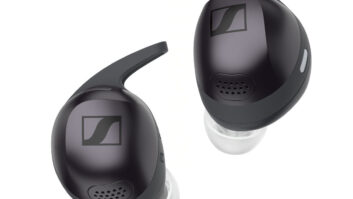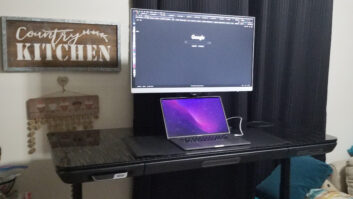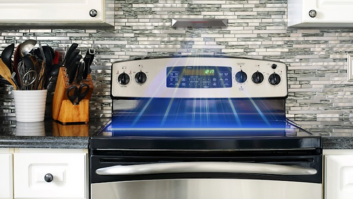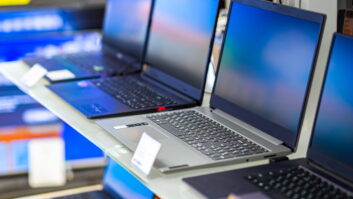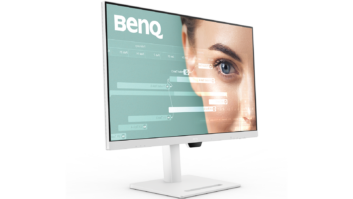Cellular phone makers have targeted a broad range of consumers in their launch of multiple business-oriented and entertainment-oriented models, including the industry’s first music phone with built-in FM transmitter to reproduce cellphone music through home and car stereo systems.
The model with built-in FM transmitter is LG’s Fusic, already available through Sprint PCS. Later in the year, Sony Ericsson will unveil its newest Walkman-brand music phone, which is compatible with an add-on FM transmitter.
Like satellite radio plug-and-play tuners and satellite headphone stereos, LG’s Fusic music phone and Sony Ericsson’s accessory let consumers hear phone-based music through nearby FM-equipped sound systems. With the Fusic, music from three sources can be beamed via FM to home and car audio systems: songs downloaded over the air to the phone from Sprint’s music store; songs transferred to the phone from a PC; and music-streaming channels available over Sprint’s airwaves, including Rhapsody Radio, MTV Mobile and Music Choice. To prevent unauthorized digital distribution of rights-protected music downloads, Fusic doesn’t stream protected music over Bluetooth to Bluetooth stereo headphones.
The CDMA 1x EV-DO device, with 1.3-megapixel camera and included 64MB microSD card, is available from Sprint PCS for $179 after rebate with two-year service agreement.
For the athletically inclined music enthusiast, Sony Ericsson unveiled its latest Walkman-brand phone, the W710, which features built-in fitness computer and ships with included armband. It is the company’s first phone with GraceNote’s Track ID music-identification application, which enables users to capture clips of music via the built-in microphone or via a built-in FM radio, send the clip over the cellular network to GraceNote, and receive a text message showing the song’s name and artist.
The W710 is due in the third quarter on the Sony Ericsson Web site and other unannounced channels at a suggested $399 before carrier subsidy. It’s a quadband 850/900/1,800/1,900MHz EDGE-equipped model with included 512MB Memory Stick Micro memory card, 2-megapixel camera, FM RDS radio and fitness applications. A jogging application, for example, measures speed and distance covered. A daily step counter resets automatically at midnight. It stores music in the unprotected MP3, AAC, AAC+ and eAAC+ formats.
For business users, Verizon released Motorola’s previously announced Q phone, a Windows Mobile 5.0 smartphone edition model whose 0.5-inch depth reportedly makes it the thinnest PDA phone with QWERTY keyboard. Also for business users, Nokia unveiled its E50 smartphone with preloaded business applications and two-line capability, enabling users to have one phone with separate personal and business numbers. The company hasn’t decided whether to ship it in the United States.
Motorola’s Q phone, however, became available May 31 on Verizon’s Web site and on June 5 through Verizon-owned outlets. It retails for $199.99 after a $100 instant credit applied to customers who buy one of three voice and data plans priced from $79 to $169 per month and sign a two-year contract.
The Q phone features CDMA 1x EV-DO broadband data; out-of-the-box corporate e-mail redirection via Microsoft Exchange Server 2003; Good Link’s e-mail redirection application for Exchange and other corporate e-mail servers; POP3 support for receiving Web-based e-mail; and Verizon’s Wireless Sync service for over-cellular synchronization of email, calendar, contacts and task entries.
The Q phone also features Bluetooth 1.2, corporate application access, standard desktop document-view support, MP3 player and stereo speakers.
Verizon also launched the previously announced Palm-based Treo 700p PDA phone with QWERTY keyboard at $399 with two-year contract. It’s available on the carrier’s Web site and in Verizon stores June 1.
Also for busy professionals, Nokia launched its E series E50 smartphone with pre-installed business applications and bar-phone form factor. Although the company hasn’t decided yet to offer it in the United States, the E50 operates in the two U.S. cellular bands at 850 and 1,900MHz and also in foreign 900 and 1,800MHz bands.
The quadband GSM-EDGE phone, based on the Symbian Series 60 smartphone platform, can be programmed with two separate phone numbers, each dedicated for personal or business use. It also supports multiple wireless e-mail redirection programs including BlackBerry Connect.
An Avaya client enables the phone to operate like a PBX phone in an enterprise’s Avaya PBX system. The smartphone displays Microsoft-application attachments and offers POP3 e-mail support. For fun, it incorporates an MP3 player and optional 1.3-megapixel camera. Pricing was unavailable.
For entertainment-oriented consumers, Nokia also unveiled the N93 and N73 multimedia phones, both with 3.2-megapixel Carl Zeiss optics. The N93 is also the company’s first camera phone with optical zoom, delivering 3x zoom, and the company’s first with 30 fps video camera. The swiveling main display flips to a landscape position for Web browsing and video viewing.
Nokia’s first phone with Zeiss optics, the N90, shipped last year in the United States.
Nokia expects the N93 and N73 to be available through U.S. retailers at prices to be determined, but they won’t be sold through carrier channels.
Only one of the phones’ four bands is a U.S. band. The phones operate on GSM-EDGE networks in the 900, 1,800 and 1,900MHz bands and in W-CDMA networks in the 2.1GHz.
The two feature stereo FM radio and playback of compressed music in the unprotected MP3, WMA, AAC, eAAC and eAAC+ formats. The step-up N93 adds rights management technology approved by the Open Mobile Alliance (OMA) for playback of the AAC, eAAC and eAAC+ formats. The N93 also incorporates IEE 802.11b/g with universal plug-and-play to transfers stored data to a wireless home network.
Nokia’s N91 GSM phone with 4GB HDD is now expected in the United States, possibly in the third quarter.
In another Nokia launch, the company shipped the first Nokia-branded, but SK Teletech-made, CDMA 1xEV-DO handset, the 6305i. It’s on sale through online retailer LetsTalk.com for use on the Verizon network with a 1.3-megapixel camera and stereo speakers. It’s available for a $150 mail-in rebate and two-year contract.





